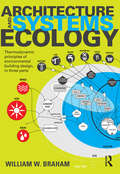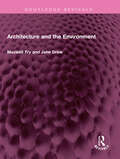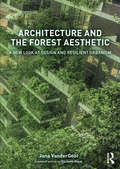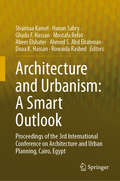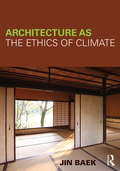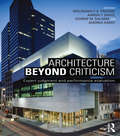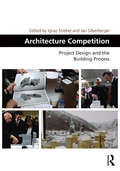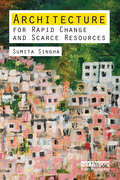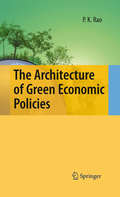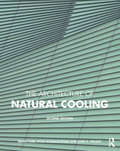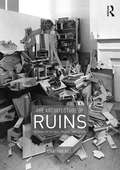- Table View
- List View
Architecture and Systems Ecology: Thermodynamic Principles of Environmental Building Design, in three parts
by William W. BrahamModern buildings are both wasteful machines that can be made more efficient and instruments of the massive, metropolitan system engendered by the power of high-quality fuels. A comprehensive method of environmental design must reconcile the techniques of efficient building design with the radical urban and economic reorganization that we face. Over the coming century, we will be challenged to return to the renewable resource base of the eighteenth-century city with the knowledge, technologies, and expectations of the twenty-first-century metropolis. This book explores the architectural implications of systems ecology, which extends the principles of thermodynamics from the nineteenth-century focus on more efficient machinery to the contemporary concern with the resilient self-organization of ecosystems. Written with enough technical material to explain the methods, it does not include in-text equations or calculations, relying instead on the energy system diagrams to convey the argument. Architecture and Systems Ecology has minimal technical jargon and an emphasis on intelligible design conclusions, making it suitable for architecture students and professionals who are engaged with the fundamental issues faced by sustainable design. The energy systems language provides a holistic context for the many kinds of performance already evaluated in architecture—from energy use to material selection and even the choice of building style. It establishes the foundation for environmental principles of design that embrace the full complexity of our current situation. Architecture succeeds best when it helps shape, accommodate, and represent new ways of living together.
Architecture and Systems Ecology: Thermodynamic Principles of Environmental Building Design, in three parts
by William W. BrahamModern buildings are both wasteful machines that can be made more efficient and instruments of the massive, metropolitan system engendered by the power of high-quality fuels. A comprehensive method of environmental design must reconcile the techniques of efficient building design with the radical urban and economic reorganization that we face. Over the coming century, we will be challenged to return to the renewable resource base of the eighteenth-century city with the knowledge, technologies, and expectations of the twenty-first-century metropolis. This book explores the architectural implications of systems ecology, which extends the principles of thermodynamics from the nineteenth-century focus on more efficient machinery to the contemporary concern with the resilient self-organization of ecosystems. Written with enough technical material to explain the methods, it does not include in-text equations or calculations, relying instead on the energy system diagrams to convey the argument. Architecture and Systems Ecology has minimal technical jargon and an emphasis on intelligible design conclusions, making it suitable for architecture students and professionals who are engaged with the fundamental issues faced by sustainable design. The energy systems language provides a holistic context for the many kinds of performance already evaluated in architecture—from energy use to material selection and even the choice of building style. It establishes the foundation for environmental principles of design that embrace the full complexity of our current situation. Architecture succeeds best when it helps shape, accommodate, and represent new ways of living together.
Architecture and the Environment (Routledge Revivals)
by Maxwell Fry Jane DrewFirst published in 1976 Architecture and the Environment is based on the authors very successful Architecture of Children. The original book has been completely revised and new illustrations have been specially drawn. This book gives a comprehensive account of the role of architecture in the environment of a constantly developing world. It traces the history of building from its most primitive origins to the complex architecture of the current times. The book takes as a starting- point ideas that will be familiar to all its readers, then leads them on to an examination of the attitudes and approaches of architects and planners, so that they can follow the creative process step by step. The style of the book is direct and very readable, with a minimum of technological language and will be useful for general readers interested in architecture.
Architecture and the Environment (Routledge Revivals)
by Maxwell Fry Jane DrewFirst published in 1976 Architecture and the Environment is based on the authors very successful Architecture of Children. The original book has been completely revised and new illustrations have been specially drawn. This book gives a comprehensive account of the role of architecture in the environment of a constantly developing world. It traces the history of building from its most primitive origins to the complex architecture of the current times. The book takes as a starting- point ideas that will be familiar to all its readers, then leads them on to an examination of the attitudes and approaches of architects and planners, so that they can follow the creative process step by step. The style of the book is direct and very readable, with a minimum of technological language and will be useful for general readers interested in architecture.
Architecture and the Forest Aesthetic: A New Look at Design and Resilient Urbanism
by Jana VanderGootDespite population trends toward urbanization, the forest continues to have a strong appeal to the human imagination, and the human preference for forest over many other types of terrain is well documented. This book re-imagines architecture and urbanism by allowing the forest to be a prominent consideration in the language of design, thus recognizing the forest as essential rather than just incidental to human well-being. In Architecture and the Forest Aesthetic, forest is a large-scale urban construct that is far more extensive and nuanced than trees and shrubbery. The forest aesthetic opens designers to the forest as a model for an urban architecture of permeable floors, protective canopies, connected food chains, beneficial decomposition, and resilient ecologies. Much can be learned about these features of the forest from the natural sciences; however, when they are given due consideration technically and metaphorically in the design of urban habitat, the places in which humans live become living forests. What is present here in Architecture and the Forest Aesthetic is both a review of many ingenious ways in which the forest aesthetic has already been expressed in design and urbanism, and an encouragement to further use the forest aesthetic in design language and design outcomes. Case study projects featured include the Chilotan building craft of Southern Chile, the yaki sugi of Japan, the Biltmore Forest in the Southeastern United States, the Australian capital city Canberra, Bosco Verticale in Milan, Italy, the Beijing Olympic Forest Park in China, and more.
Architecture and the Forest Aesthetic: A New Look at Design and Resilient Urbanism
by Jana VanderGootDespite population trends toward urbanization, the forest continues to have a strong appeal to the human imagination, and the human preference for forest over many other types of terrain is well documented. This book re-imagines architecture and urbanism by allowing the forest to be a prominent consideration in the language of design, thus recognizing the forest as essential rather than just incidental to human well-being. In Architecture and the Forest Aesthetic, forest is a large-scale urban construct that is far more extensive and nuanced than trees and shrubbery. The forest aesthetic opens designers to the forest as a model for an urban architecture of permeable floors, protective canopies, connected food chains, beneficial decomposition, and resilient ecologies. Much can be learned about these features of the forest from the natural sciences; however, when they are given due consideration technically and metaphorically in the design of urban habitat, the places in which humans live become living forests. What is present here in Architecture and the Forest Aesthetic is both a review of many ingenious ways in which the forest aesthetic has already been expressed in design and urbanism, and an encouragement to further use the forest aesthetic in design language and design outcomes. Case study projects featured include the Chilotan building craft of Southern Chile, the yaki sugi of Japan, the Biltmore Forest in the Southeastern United States, the Australian capital city Canberra, Bosco Verticale in Milan, Italy, the Beijing Olympic Forest Park in China, and more.
Architecture and Urbanism: Proceedings of the 3rd International Conference on Architecture and Urban Planning, Cairo, Egypt
by Shaimaa Kamel Hanan Sabry Ghada F. Hassan Mostafa Refat Abeer Elshater Ahmed S. Abd Elrahman Doaa K. Hassan Rowaida RashedThis proceedings addresses the challenges of urbanization that gravely affect the world’s ecosystems. To become efficiently sustainable and regenerative, buildings and cities need to adopt smart solutions. This book discusses innovations of the built environment while depicting how such practices can transform future buildings and urban areas into places of higher value and quality. The book aims to examine the interrelationship between people, nature and technology, which is essential in pursuing smart environments that optimize human wellbeing, motivation and vitality, as well as promoting cohesive and inclusive societies: Urban Sociology - Community Involvement - Place-making and Cultural Continuity – Environmental Psychology - Smart living - Just City. The book presents exemplary practical experiences that reflect smart strategies, technologies and innovations, by established and emerging professionals, provides a forum of real-life discourse. The primary audience for the work will be from the fields of architecture, urban planning and built-environment systems, including multi-disciplinary academics as well as professionals.
Architecture as the Ethics of Climate
by Jin BaekAt a time when climate and ethics have become so important to architectural debate, this book proposes an entirely new way for architects to engage with these core issues. Drawing on Tetsuro Watsuji‘s (1889-1960) philosophy, the book illuminates climate not as a collection of objective natural phenomena, but as a concrete form of bond in which "who we are"—the subjective human experience—is indivisibly intertwined with the natural phenomena. The book further elucidates the inter-personal nature of climatic experiences, criticizing a view that sees atmospheric effects of climate under the guise of personal experientialism and reinforcing the linkage between climate and ethos as the appropriateness of a setting for human affairs. This ethical premise of climate stretches the horizon of sustainability as pertaining not only to man’s solitary relationship with natural phenomena—a predominant trend in contemporary discourse of sustainability—but also to man’s relationship with man. Overcoming climatic determinism—regional determinism, too—and expanding the ethics of the inter-personal to the level where the whole and particulars are joined through the dialectics of the mutually-negating opposites, Jin Baek develops a new thesis engaging with the very urgent issues inherent in sustainable architecture. Crucially, the book explores examples that join climate and the dynamics of the inter-personal, including: Japanese vernacular residential architecture the white residential architecture of Richard Neutra contemporary architectural works and urban artifacts by Tadao Ando and Aldo Rossi Beautifully illustrated, this book is an important contribution to the discourse which surrounds architecture, climate and ethics and encourages the reader to think more broadly about how to respond to the current challenges facing the profession.
Architecture as the Ethics of Climate
by Jin BaekAt a time when climate and ethics have become so important to architectural debate, this book proposes an entirely new way for architects to engage with these core issues. Drawing on Tetsuro Watsuji‘s (1889-1960) philosophy, the book illuminates climate not as a collection of objective natural phenomena, but as a concrete form of bond in which "who we are"—the subjective human experience—is indivisibly intertwined with the natural phenomena. The book further elucidates the inter-personal nature of climatic experiences, criticizing a view that sees atmospheric effects of climate under the guise of personal experientialism and reinforcing the linkage between climate and ethos as the appropriateness of a setting for human affairs. This ethical premise of climate stretches the horizon of sustainability as pertaining not only to man’s solitary relationship with natural phenomena—a predominant trend in contemporary discourse of sustainability—but also to man’s relationship with man. Overcoming climatic determinism—regional determinism, too—and expanding the ethics of the inter-personal to the level where the whole and particulars are joined through the dialectics of the mutually-negating opposites, Jin Baek develops a new thesis engaging with the very urgent issues inherent in sustainable architecture. Crucially, the book explores examples that join climate and the dynamics of the inter-personal, including: Japanese vernacular residential architecture the white residential architecture of Richard Neutra contemporary architectural works and urban artifacts by Tadao Ando and Aldo Rossi Beautifully illustrated, this book is an important contribution to the discourse which surrounds architecture, climate and ethics and encourages the reader to think more broadly about how to respond to the current challenges facing the profession.
Architecture Beyond Criticism: Expert Judgment and Performance Evaluation
by Wolfgang F. Preiser Aaron T. Davis Ashraf M. Salama Andrea HardyFor the first time, this book demonstrates that the two paradigms of architectural criticism and performance evaluation can not only co-exist but complement each other in the assessment of built works. As architecture takes more principled stances worldwide, from environmental sustainability to social, cultural, and economic activism, this book examines the roles of perceived and measured quality in architecture. By exploring in tandem both subjective traditional architectural criticism and environmental design and performance evaluation and its objective evaluation criteria, the book argues that both methodologies and outcomes can achieve a comprehensive assessment of quality in architecture. Curated by a global editorial team, the book includes: Contributions from international architects and critics based in the UK, USA, Brazil, France, Qatar, Egypt, New Zealand, China, Japan and Germany Global case studies which illustrate both perspectives addressed by the book and comparative analyses of the findings A six part organization which includes introductions and conclusions from the editors, to help guide the reader and further illuminate the contributions. By presenting a systematic approach to assessing building performance, design professionals will learn how to improve building design and performance with major stakeholders in mind, especially end users/occupants.
Architecture Beyond Criticism: Expert Judgment and Performance Evaluation
by Wolfgang F. Preiser Aaron T. Davis Ashraf M. Salama Andrea HardyFor the first time, this book demonstrates that the two paradigms of architectural criticism and performance evaluation can not only co-exist but complement each other in the assessment of built works. As architecture takes more principled stances worldwide, from environmental sustainability to social, cultural, and economic activism, this book examines the roles of perceived and measured quality in architecture. By exploring in tandem both subjective traditional architectural criticism and environmental design and performance evaluation and its objective evaluation criteria, the book argues that both methodologies and outcomes can achieve a comprehensive assessment of quality in architecture. Curated by a global editorial team, the book includes: Contributions from international architects and critics based in the UK, USA, Brazil, France, Qatar, Egypt, New Zealand, China, Japan and Germany Global case studies which illustrate both perspectives addressed by the book and comparative analyses of the findings A six part organization which includes introductions and conclusions from the editors, to help guide the reader and further illuminate the contributions. By presenting a systematic approach to assessing building performance, design professionals will learn how to improve building design and performance with major stakeholders in mind, especially end users/occupants.
Architecture Competition: Project Design and the Building Process (Design and the Built Environment)
by Ignaz Strebel Jan SilberbergerMuch valued by design professionals, controversially discussed in the media, regularly misunderstood by the public and systematically regulated by public procurement; in recent years, architecture competitions have become projection screens for various and often incommensurable desires and hopes. Almost all texts on architectural competition engage it for particular reasons, whether these be for celebration of the procedure, or dismissal. Moving on from such polarised views, Architecture Competition is a revelatory study on what really happens when competitions take place. But the story is not just about architecture and design; it is about the whole construction process, from the definition of the spatial programme, to judgement and selection of projects and the realization of the building. This book explores the competition in the building process as it takes place, but also before and after its execution. It demonstrates that competitions are not just one step of many to be taken, but that competitive design procedures shape the entire process. Along the way the book exposes, among others, one of the key evolutions of design competitions – that competition procedures need to be regulated in order to respond to public awarding rules and need to integrate an increasing amount of given standards regarding, for example, efficiency, fire safety and thermal comfort. These notions force competing architects to respond to inflexible and overloaded competition programmes instead of focusing on genuinely crafting an architectural project. If the architecture competition wants to be more highly valued as a design tool, it should pay attention to the iterative nature of design and to the fact that perspectives on the problem often change in process.
Architecture Competition: Project Design and the Building Process (Design and the Built Environment)
by Ignaz Strebel Jan SilberbergerMuch valued by design professionals, controversially discussed in the media, regularly misunderstood by the public and systematically regulated by public procurement; in recent years, architecture competitions have become projection screens for various and often incommensurable desires and hopes. Almost all texts on architectural competition engage it for particular reasons, whether these be for celebration of the procedure, or dismissal. Moving on from such polarised views, Architecture Competition is a revelatory study on what really happens when competitions take place. But the story is not just about architecture and design; it is about the whole construction process, from the definition of the spatial programme, to judgement and selection of projects and the realization of the building. This book explores the competition in the building process as it takes place, but also before and after its execution. It demonstrates that competitions are not just one step of many to be taken, but that competitive design procedures shape the entire process. Along the way the book exposes, among others, one of the key evolutions of design competitions – that competition procedures need to be regulated in order to respond to public awarding rules and need to integrate an increasing amount of given standards regarding, for example, efficiency, fire safety and thermal comfort. These notions force competing architects to respond to inflexible and overloaded competition programmes instead of focusing on genuinely crafting an architectural project. If the architecture competition wants to be more highly valued as a design tool, it should pay attention to the iterative nature of design and to the fact that perspectives on the problem often change in process.
Architecture for Rapid Change and Scarce Resources
by Sumita SinhaArchitects, development practitioners and designers are working in a global environment and issues such as environmental and cultural sustainability matter more than ever. Past interactions and interventions between developed and developing countries have often been unequal and inappropriate. We now need to embrace fresh design practices based on respect for diversity and equality, participation and empowerment. This book explores what it means for development activists to practise architecture on a global scale, and provides a blueprint for developing architectural practices based on reciprocal working methods. The content is based on real situations - through extended field research and contacts with architecture schools and architects, as well as participating NGOs. It demonstrates that the ability to produce appropriate and sustainable design is increasingly relevant, whether in the field of disaster relief, longer-term development or wider urban contexts, both in rich countries and poor countries.
Architecture for Rapid Change and Scarce Resources
by Sumita SinhaArchitects, development practitioners and designers are working in a global environment and issues such as environmental and cultural sustainability matter more than ever. Past interactions and interventions between developed and developing countries have often been unequal and inappropriate. We now need to embrace fresh design practices based on respect for diversity and equality, participation and empowerment. This book explores what it means for development activists to practise architecture on a global scale, and provides a blueprint for developing architectural practices based on reciprocal working methods. The content is based on real situations - through extended field research and contacts with architecture schools and architects, as well as participating NGOs. It demonstrates that the ability to produce appropriate and sustainable design is increasingly relevant, whether in the field of disaster relief, longer-term development or wider urban contexts, both in rich countries and poor countries.
The Architecture of Clouds
by Howard B. BluesteinThe Architecture of Clouds describes in a visual, poetic, and personal way how clouds are related to our everyday life and the weather. It expertly details how the art and science of clouds are interconnected with straightforward scientific explanations of the meteorological context in which clouds appear and why they form, alongside in-depth descriptions of the visual and artistic aspects of clouds. The air motion dynamics, cloud microphysics and thermodynamics discussed are written in a style accessible to all readers. The clouds showcased within the text range from placid ground fog to smoothly sculpted, stationary, mountain-wave clouds to violent clouds associated with convective storms, tornadoes, and hurricanes. Clouds are classified as whether they are buoyant or not, and if they are, how deep they extend through the atmosphere. An exhaustive and impressive compilation of photos taken from all over the world, including photographs taken from satellites, are featured in each chapter. Radar depictions of the inside of some clouds and storms provide a unique addition. This book provides an abundance of detail and photography that will be appreciated by scientists, students, and any reader interested in exploring beyond the aesthetics of clouds.
The Architecture of Green Economic Policies
by P.K. RaoAfter numerous scienti?c papers and books on most aspects of climate change and the design of pro-environmental policies (including some that suit some industrial lobby or another), is there relevance for another book and what is the purported role of this one? Is this yet another academic exercise or “much ado about nothing”? Do we have to bother designing green economic policies and incur transaction costs of this effort? Are there shortcomings of existing policies if we care to live “happily” on this planet? Is it not enough to care for the current generations so that the future generations can take care of themselves (or even be given the incentives for in- vations – for lack of fully provided resources)? What can “we” do about the green economic policies (and what are these anyway)? What trade-offs, if any, are re- vant in foregoing some bene?ts and in incurring some costs (not all of which can be expressed in monetary units)? What are the overarching objectives and priorities in the current context? What economic and other approaches are relevant for atta- ing the objectives? These are some of the questions the author re?ected in writing this book.
The Architecture of Natural Cooling
by Brian Ford Rosa Schiano-Phan Juan A. VallejoOverheating in buildings is commonplace. This book describes how we can keep cool without conventional air-conditioning: improving comfort and productivity while reducing energy costs and carbon emissions. It provides architects, engineers and policy makers with a ‘how-to’ guide to the application of natural cooling in new and existing buildings. It demonstrates, through reference to numerous examples, that natural cooling is viable in most climates around the world. This completely revised and expanded second edition includes: An overview of natural cooling past and present. Guidance on the principles and strategies that can be adopted. A review of the applicability of different strategies. Explanation of simplified tools for performance assessment. A review of components and controls. A detailed evaluation of case studies from the USA, Europe, India and China. This book is not just for the technical specialist, as it also provides a general grounding in how to avoid or minimise air-conditioning. Importantly, it demonstrates that understanding our environment, rather than fighting it, will help us to live sustainably in our rapidly warming world.
The Architecture of Natural Cooling
by Brian Ford Rosa Schiano-Phan Juan A. VallejoOverheating in buildings is commonplace. This book describes how we can keep cool without conventional air-conditioning: improving comfort and productivity while reducing energy costs and carbon emissions. It provides architects, engineers and policy makers with a ‘how-to’ guide to the application of natural cooling in new and existing buildings. It demonstrates, through reference to numerous examples, that natural cooling is viable in most climates around the world. This completely revised and expanded second edition includes: An overview of natural cooling past and present. Guidance on the principles and strategies that can be adopted. A review of the applicability of different strategies. Explanation of simplified tools for performance assessment. A review of components and controls. A detailed evaluation of case studies from the USA, Europe, India and China. This book is not just for the technical specialist, as it also provides a general grounding in how to avoid or minimise air-conditioning. Importantly, it demonstrates that understanding our environment, rather than fighting it, will help us to live sustainably in our rapidly warming world.
The Architecture of Persistence: Designing for Future Use
by David Fannon Michelle Laboy Peter WiederspahnThe Architecture of Persistence argues that continued human use is the ultimate measure of sustainability in architecture, and that expanding the discourse about adaptability to include continuity as well as change offers the architectural manifestation of resilience. Why do some buildings last for generations as beloved and useful places, while others do not? How can designers today create buildings that remain useful into the future? While architects and theorists have offered a wide range of ideas about building for change, this book focuses on persistent architecture: the material, spatial, and cultural processes that give rise to long-lived buildings. Organized in three parts, this book examines material longevity in the face of constant physical and cultural change, connects the dimensions of human use and contemporary program, and discusses how time informs the design process. Featuring dozens of interviews with people who design and use buildings, and a close analysis of over a hundred historic and contemporary projects, the principles of persistent architecture introduced here address urgent challenges for contemporary practice while pointing towards a more sustainable built environment in the future. The Architecture of Persistence: Designing for Future Use offers practitioners, students, and scholars a set of principles and illustrative precedents exploring architecture’s unique ability to connect an instructive past, a useful present, and an unknown future.
The Architecture of Persistence: Designing for Future Use
by David Fannon Michelle Laboy Peter WiederspahnThe Architecture of Persistence argues that continued human use is the ultimate measure of sustainability in architecture, and that expanding the discourse about adaptability to include continuity as well as change offers the architectural manifestation of resilience. Why do some buildings last for generations as beloved and useful places, while others do not? How can designers today create buildings that remain useful into the future? While architects and theorists have offered a wide range of ideas about building for change, this book focuses on persistent architecture: the material, spatial, and cultural processes that give rise to long-lived buildings. Organized in three parts, this book examines material longevity in the face of constant physical and cultural change, connects the dimensions of human use and contemporary program, and discusses how time informs the design process. Featuring dozens of interviews with people who design and use buildings, and a close analysis of over a hundred historic and contemporary projects, the principles of persistent architecture introduced here address urgent challenges for contemporary practice while pointing towards a more sustainable built environment in the future. The Architecture of Persistence: Designing for Future Use offers practitioners, students, and scholars a set of principles and illustrative precedents exploring architecture’s unique ability to connect an instructive past, a useful present, and an unknown future.
The Architecture of Ruins: Designs on the Past, Present and Future
by Jonathan HillThe Architecture of Ruins: Designs on the Past, Present and Future identifies an alternative and significant history of architecture from the sixteenth century to the twenty-first century, in which a building is designed, occupied and imagined as a ruin. This design practice conceives a monument and a ruin as creative, interdependent and simultaneous themes within a single building dialectic, addressing temporal and environmental questions in poetic, psychological and practical terms, and stimulating questions of personal and national identity, nature and culture, weather and climate, permanence and impermanence and life and death. Conceiving a building as a dialogue between a monument and a ruin intensifies the already blurred relations between the unfinished and the ruined and envisages the past, the present and the future in a single architecture. Structured around a collection of biographies, this book conceives a monument and a ruin as metaphors for a life and means to negotiate between a self and a society. Emphasising the interconnections between designers and the particular ways in which later architects learned from earlier ones, the chapters investigate an evolving, interdisciplinary design practice to show the relevance of historical understanding to design. Like a history, a design is a reinterpretation of the past that is meaningful to the present. Equally, a design is equivalent to a fiction, convincing users to suspend disbelief. We expect a history or a novel to be written in words, but they can also be delineated in drawing, cast in concrete or seeded in soil. The architect is a ‘physical novelist’ as well as a ‘physical historian’. Like building sites, ruins are full of potential. In revealing not only what is lost, but also what is incomplete, a ruin suggests the future as well as the past. As a stimulus to the imagination, a ruin’s incomplete and broken forms expand architecture’s allegorical and metaphorical capacity, indicating that a building can remain unfinished, literally and in the imagination, focusing attention on the creativity of users as well as architects. Emphasising the symbiotic relations between nature and culture, a building designed, occupied and imagined as a ruin acknowledges the coproduction of multiple authors, whether human, non-human or atmospheric, and is an appropriate model for architecture in an era of increasing climate change.
The Architecture of Ruins: Designs on the Past, Present and Future
by Jonathan HillThe Architecture of Ruins: Designs on the Past, Present and Future identifies an alternative and significant history of architecture from the sixteenth century to the twenty-first century, in which a building is designed, occupied and imagined as a ruin. This design practice conceives a monument and a ruin as creative, interdependent and simultaneous themes within a single building dialectic, addressing temporal and environmental questions in poetic, psychological and practical terms, and stimulating questions of personal and national identity, nature and culture, weather and climate, permanence and impermanence and life and death. Conceiving a building as a dialogue between a monument and a ruin intensifies the already blurred relations between the unfinished and the ruined and envisages the past, the present and the future in a single architecture. Structured around a collection of biographies, this book conceives a monument and a ruin as metaphors for a life and means to negotiate between a self and a society. Emphasising the interconnections between designers and the particular ways in which later architects learned from earlier ones, the chapters investigate an evolving, interdisciplinary design practice to show the relevance of historical understanding to design. Like a history, a design is a reinterpretation of the past that is meaningful to the present. Equally, a design is equivalent to a fiction, convincing users to suspend disbelief. We expect a history or a novel to be written in words, but they can also be delineated in drawing, cast in concrete or seeded in soil. The architect is a ‘physical novelist’ as well as a ‘physical historian’. Like building sites, ruins are full of potential. In revealing not only what is lost, but also what is incomplete, a ruin suggests the future as well as the past. As a stimulus to the imagination, a ruin’s incomplete and broken forms expand architecture’s allegorical and metaphorical capacity, indicating that a building can remain unfinished, literally and in the imagination, focusing attention on the creativity of users as well as architects. Emphasising the symbiotic relations between nature and culture, a building designed, occupied and imagined as a ruin acknowledges the coproduction of multiple authors, whether human, non-human or atmospheric, and is an appropriate model for architecture in an era of increasing climate change.
The Architecture of Waste: Design for a Circular Economy
by Caroline O’DonnellGlobal material crises are imminent. In the very near future, recycling will no longer be a choice made by those concerned about the environment, but a necessity for all. This means a paradigm shift in domestic behavior, manufacturing, construction, and design is inevitable. The Architecture of Waste provides a hopeful outlook through examining current recycling practices, rethinking initial manufacturing techniques, and proposing design solutions for second lives of material-objects. The book touches on a variety of inescapable issues beyond our global waste crisis including cultural psyches, politics, economics, manufacturing, marketing, and material science. A series of crucial perspectives from experts cover these topics and frames the research by providing a past, present, and future look at how we got here and where we go next: the historical, the material, and the design. Twelve design proposals look beyond the simple application of recycled and waste materials in architecture—an admirable endeavor but one that does not engage the urgent reality of a circular economy—by aiming to transform familiar, yet flawed, material-objects into closed-loop resources. Complete with over 150 color images and written for both professionals and students, The Architecture of Waste is a necessary reference for rethinking the traditional role of the architect and challenging the discipline to address urgent material issues within the larger design process.
The Architecture of Waste: Design for a Circular Economy
by Caroline O'Donnell Dillon PrangerGlobal material crises are imminent. In the very near future, recycling will no longer be a choice made by those concerned about the environment, but a necessity for all. This means a paradigm shift in domestic behavior, manufacturing, construction, and design is inevitable. The Architecture of Waste provides a hopeful outlook through examining current recycling practices, rethinking initial manufacturing techniques, and proposing design solutions for second lives of material-objects. The book touches on a variety of inescapable issues beyond our global waste crisis including cultural psyches, politics, economics, manufacturing, marketing, and material science. A series of crucial perspectives from experts cover these topics and frames the research by providing a past, present, and future look at how we got here and where we go next: the historical, the material, and the design. Twelve design proposals look beyond the simple application of recycled and waste materials in architecture—an admirable endeavor but one that does not engage the urgent reality of a circular economy—by aiming to transform familiar, yet flawed, material-objects into closed-loop resources. Complete with over 150 color images and written for both professionals and students, The Architecture of Waste is a necessary reference for rethinking the traditional role of the architect and challenging the discipline to address urgent material issues within the larger design process.
